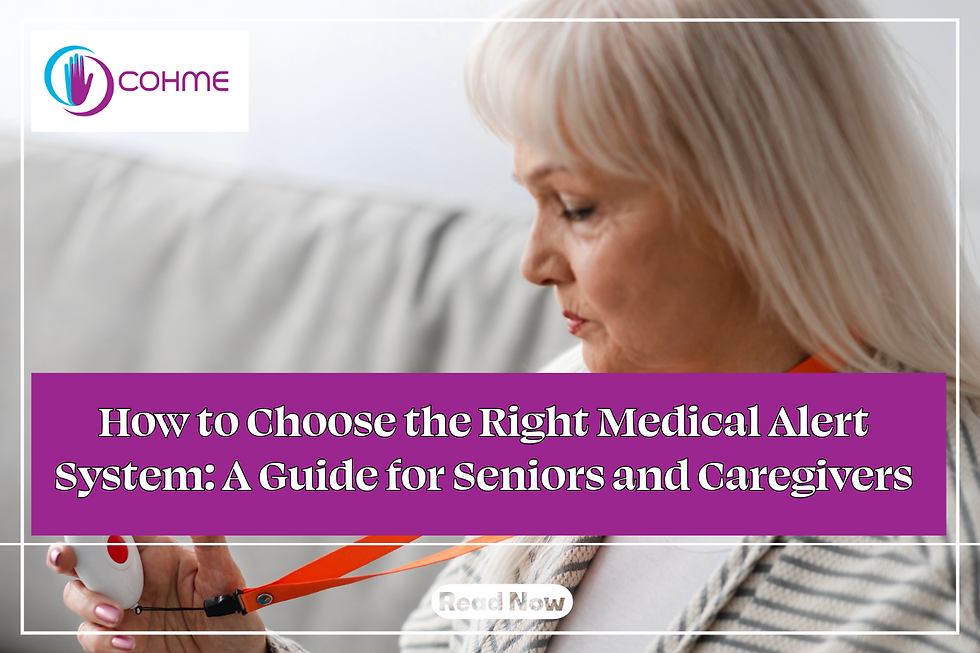How to Choose the Right Medical Alert System: A Guide for Seniors and Caregivers
- admincohme
- Aug 29
- 3 min read
By Emma Pizzuti

As we get older, maintaining independence while staying safe becomes more and more important. Many seniors want the reassurance of knowing that if something goes wrong—whether it’s a fall, a sudden health issue, or another emergency—help will be available quickly. A medical alert system can provide that peace of mind. These systems allow you to connect with trained responders or designated caregivers at the push of a button, helping you feel more secure at home and when you’re out and about.
With so many products available, it can be hard to know which one is right for you. Here’s what to think about when choosing a medical alert system for yourself or a loved one.
Understanding the Different Types of Medical Alert Systems
Medical alert systems are not all the same, and choosing the right one often comes down to lifestyle. In-home systems are designed for people who spend most of their time at home. These typically include a base station that connects to a landline or cellular network, along with a wearable device such as a pendant or wristband. If you push the button, you’re connected to a monitoring center through the base station. These are often simple and cost-effective, but they only work within a certain range of the base unit.
Mobile systems, on the other hand, work outside the home using cellular technology. They are often equipped with GPS tracking, which means help can be dispatched directly to your location. These are better suited for more active seniors who may go shopping, take walks, or travel.
Some systems also offer fall detection technology. This means the device can sense when you fall and automatically send an alert, even if you’re unable to press the button. For people with balance issues, a history of falls, or conditions that could cause sudden loss of consciousness, this feature can be extremely valuable.
Key Features to Look For
Once you know the type of system that fits your lifestyle, the next step is to look at the features offered. Around-the-clock monitoring is one of the most important. Make sure the service you choose is staffed 24/7, so you can always reach someone, day or night.
Water resistance is another must-have feature, since many accidents happen in the bathroom. Being able to wear your device in the shower ensures you’re protected in one of the most common fall-risk areas.
You’ll also want to pay attention to the range if you’re choosing an in-home system. Some devices may only work within a few hundred feet of the base station, while others cover much larger areas. For mobile systems, check coverage areas to make sure they’ll work wherever you normally spend time.
Battery life is also important. Some wearable devices need charging every day, while others last for weeks. If remembering to charge devices is a challenge, you’ll want one with long-lasting batteries. Finally, consider how easy it is to use. Large, clear buttons and simple instructions are crucial, especially if you have arthritis, vision issues, or just want something straightforward.
Questions to Ask Before You Decide
As you compare different systems, it helps to ask a few practical questions. Does the system work with the type of phone service you have, especially if you live in an area with weak cellular coverage? Can you include family members or caregivers as part of your emergency contact list, so they’re notified if you call for help?
You’ll also want to find out if fall detection is included or costs extra, since this can significantly raise the monthly fee. Ask about return policies and trial periods, which can give you time to test the system in your daily routine. It’s also worth asking how the system handles power outages and whether there’s a backup battery in the base unit.
Balancing Cost and Value
Cost is always a concern, but it’s important to think about what you’re really paying for: peace of mind and safety. Some systems have low monthly fees but fewer features, while others may be more expensive but include GPS tracking, automatic fall detection, or caregiver apps that allow family members to check in. Be sure to ask about any hidden fees, such as activation charges, equipment costs, or cancellation penalties. It may help to make a list of “must-have” features versus “nice-to-have” extras so you can compare systems more clearly.
Choosing a medical alert system is about finding the right balance between safety, convenience, and independence. The best system is the one that fits your daily lifestyle, is easy to use, and gives you confidence that help is always within reach. Take your time to explore different options, ask questions, and even try out a system before committing. For many seniors and their families, the right medical alert device offers not only protection in emergencies but also peace of mind in everyday life.



